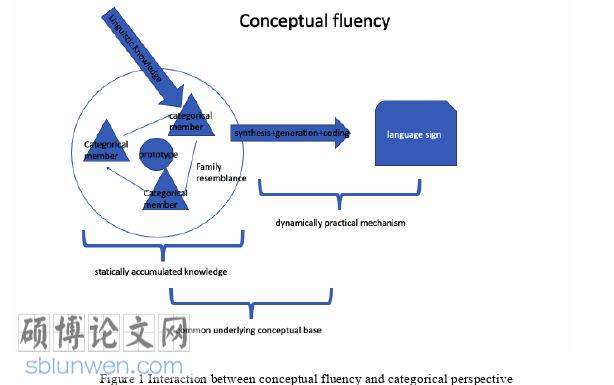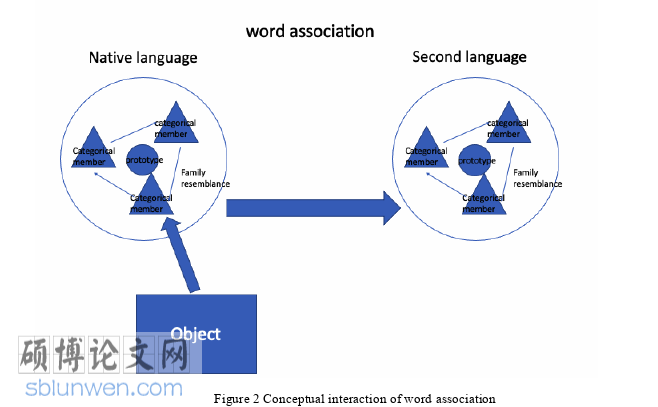Chapter One Introduction
1.1 Research Background
Conceptual fluency is defined as the ability to “close-to-native understanding and practice of concepts” (Kecskes, 2000). The incremental development of the learner’s conceptual fluency signifies the maturity of specific conceptual knowledge storage and invoking mechanism—the “statically accumulated knowledge” and the ability out of “dynamically practical mechanism” which are essential for the coalition of target language’s surface representation and the covert concepts.
Conventional second language acquisition study regards nativist and environmentalist visions as the entry point (Freeman, 1991). In the past 20 years, the escalation of cognitive science with conceptual fluency hypothesis suggests the interaction between hard-wired and external factors (Wen & Jiang, 2001), exploring the subject’s abilities while facing specific conceptualization requests (Jiang, 2009). So such fluency is also recognized as “conceptual competence”. The unity between the internal and the external indicates that the exploration for conceptual fluency needs to consider both the properties of the object and the cognitive mechanism from the subject. Research on conceptual fluency has gradually become the primary method to explore the transfer from the mother tongue in view of the first language’s interference to the second in L2 learner’s cognition. Therefore, the quest for accuracy has altered its research methodology from general inductive-based qualitative research to inference-based quantitative research. Former qualitative analyses shed light on second language learners’ “dual language systems” enclosing mother language and second language’s two pairs of “statically accumulated knowledge” and “dynamically practical mechanism”. Limited by the primacy effect, the native language system tends to overtake the accumulation and activation system through the second language acquisition development, which causes the mother language’s imprints in the learners’ input capabilities of the second language, that is, “covert nonnative-likeness” (Jiang, 2015).
...............................
1.2 Research Question
In summary, based on the theory of conceptual fluency and dual language systems, this article explores the externalization mode of “statically accumulated knowledge” and “dynamically practical mechanism” in C-ESL’s summary writing initiated by the varying language background. Essentially, it is a study for specific differences between English and Chinese languages in the cognitive domain.
Specifically, on the strength of the hypothesis of conceptual fluency, this research conducts a comparative study for the influence of mother tongue background on summary writing and further confirms whether the crux of the C-ESL’s English summary writing dwells in the ability to nominalize concepts and the specific textual externalization mode of such fluency. It is believed that C-ESL’s hindrance is in the process of accumulation and processing for nominalization of the original information in the summary writing, resulting in insufficient compression and interpretation of the message and further leads to insufficient textual anaphora and thematic deviation, finally contributing to non-native like style in English summary writing.
This paper collects the summary writing results of C-ESL of English majors and students with English as a first language for textual analysis through corpus methods such as Antword profiler and Antconc so as to investigate the specific differences between the conceptual fluency representations and their impact on textual cohesion strategy in the summary writing. The questions to be studied are as follows:
(1) Are there any differences in the overall vocabulary complexity (statically accumulated knowledge) in the English summary writing for students with different language backgrounds?
(2) Are there any differences in the use of nouns (statically accumulated knowledge) by students of different language backgrounds?
(3) Are there any differences in topic prominence from the original text (dynamically practical mechanism) by the keyword list in the summary writing between students of different language backgrounds?
(4) In the frequency of keywords in the summary writing of students with different language backgrounds, to what extent are the nouns (statically accumulated knowledge and dynamically practical mechanism) involved in the topic prominence?
..............................
Chapter Two Literature Review
2.1 Conceptual Fluency 's Externalization in Summary Writing
This chapter mainly discusses the conceptual fluency externalization modality sketched out in summary from lexical and textual perspective for the preparation of conceptual ground.
2.1.1 Internal Mechanism of Conceptual Fluency
Over the years, domestic and abroad scholars have continuously provide their awareness of more particular enquiry of conceptual fluency's internal mechanism for second languages. Known as a metaphorical competence, such a mechanism serves as the subjects' ability of cross-domain mapping and concepts integration (Danesi, 1992). Based on the metaphorical competence theory of Danesi (1992), the conceptual fluency theory was extended by Kecskes (2000), the ability of conceptual generation and encoding with authenticity and accuracy. The more knowledge reserves, the more situation-bound the subject has. The conversational ability test within the English EFL group and the English mother tongue group reveals the insufficiency of the situation-bound knowledge from the EFL group, with limited generating and encoding abilities under pragmatic discourse, leading to verbosity, overuse, oversimplification and ignoring the key information. Based on the above discovery, Kecskes believes that the subsymbolic sensitivity of EFL learners encompasses two separate systems from both their mother tongue and second language—the “dual language systems”. The less developed “statically accumulated knowledge” and “dynamically practical mechanism” of the second language contributes to the nature of L1 transfer, the side effect from the mother language over the second language. Meanwhile, the mastery of second language's accumulation and invocation toward certain annotated lexicon represents the so-called conceptual fluency. Kecskes (2005) further developed a taxonomy between high and low conceptual fluency. The former is the “concept mediation”, which is expressed as the subject's independent activation of the accumulation system; the latter is the “word association” of the “dual language systems”.
............................
2.2 Conceptual Fluency and Categorical Perspective
Subject's conceptualization of objective instance constitutes the underlying conceptual knowledge, part of which forms the “statically accumulated knowledge” for further encoding processing device (Jiang, 2015). According to cognitive psychology: the conceptualization of object adheres to the “gestalt principle” (Ungere & Schmidt, 2009). Such conceptualization relies predominately on the object’s holistic sensitivity and then a detailed description for completion. The concepts’ holistic perception determines the inter-concept’s relationship and their level of typicality. The gestalt principle is therefore, subdivided into “principle of proximity”, “principle of similarity”, “principle of closure” and “principle of continuation”. All detailed impressions out of Gestalt principle formulate the attributes cluster from category member that adheres to the principle of family resemblance, a network of overlapping similarities.
Since the conceptualization of object follows the gestalt principle, the functionally relevant parts of each members construct the prototype, an organism of the related attributes cluster, determining the typicality’s hierarchy, the goodness magnitude from the good samples to the bad samples. Among the attributes cluster, overlapping contribution to specific members’ impression, representation of family resemblance— a concept only needs one attribute overlapping with a cluster for the minimal qualification as the cluster’s categorical member. The family resemblance provides theoretical explanation for attributes’ contribution to the internal structure of prototypical category even if they are not common to all category members. Finally, the varying categorical members with a varying distribution of central attributes attribute to the arbitrariness of subjects' experience and cultural subconsciousness.

英语论文参考
Chapter Three Methodology ................... 17
3.1 Research Theory ............................ 17
3.2 Participants .................................... 18
3.3 Context ........................ 18
Chapter Four Results and Discussions ......................... 21
4.1 Vocabulary Complexity ............................. 21
4.2 Noun Density ......................................................... 23
4.3 Topic Summarization and Integration Performance ......................... 24
Chapter Five Conceptual Fluency’s Varying Externalization Pattern .................. 34
5.1 Impact from Chinese on Fluency’s Externalization Pattern ........................ 34
5.1.1 Impact on Lexical Complexity ........................... 34
5.1.2. Impact on Noun Density ................................ 35
Chapter Five Conceptual Fluency’s Varying Externalization Pattern
5.1 Impact from Chinese on Fluency’s Externalization Pattern
This section’s emphasis is on the C-ESL group’s concept generation and encoding ability in summary writing and its further impact on verbosity, low information density, nonnative-like textual structure and ambiguous textual topic. This section is divided into four parts: impact on externalization pattern from Chinese as mother language to English summary writing's lexical complexity, noun density, topic saliency, textual cohesion.
5.1.1 Impact on Lexical Complexity
Research demonstrates the C-ESLs' reliance on the mother language system, the “word association” mechanism for concept retrieving, encoding and output (Kecskes & Isabel, 2005). Such procedure represents the domination of the Chinese conceptual processing channel. After storing the external message, Chinese lexical activation channel will dominantly retrieve the concept into Chinese and then translate the second-handed concept into English. Because of deficient effective correction and feedback, such conceptual input and output pattern in turn compromises student's understanding of English-based conceptual knowledge. Lack of in-depth understanding (Kaivanpanah, 2019) further snuffs out the dynamic conceptual retrieving and encoding capacity, a vicious circle. From the perspective of conceptual fluency, the above-mentioned mechanism showcases the mother language's negative transfer reflecting the migration of Chinese dynamic activation strategy to English, therefore enables a substitution of English statically accumulated knowledge mechanism. And such static transfer further influences the dynamic generation and encoding patterns. In other words, because of the insufficient understanding of Chinese-English conceptual knowledge difference, the subject's concept and lexical storage are compromised by its reliance on Chinese activation channel for both conceptualization and information repacking as long-term memory. Because of the discrepant conceptualization patterns between English and Chinese parties, like the penchant for noun and noun phrases in English text but verb or verb phrase in Chinese to encoding the same semantic unit, the negative transfer from Chinese impedes the output of complex English vocabulary, which may explain the low lexical complexity of Chinese C-ESL group's summary writing. In essence, it reflects the insufficient accumulation and activation of specific concept knowledge.

英语论文怎么写
Chapter Six Conclusions
6.1 Major Findings
Conceptual fluency is an academic framework for investigating the unfathomable mechanism of language input and output, a novel perspective for second language acquisition and cross-language research. Based on the hypothesis, this article believes that word association generation and encoding processes lead to a low level of conceptual fluency, which is mainly manifested by the insufficiency of nominalized concepts. The insufficiency may be triggered by the C-ESL group’s deficient accumulation and invocation knowledge of English concepts and their prototypical category’s organization and distribution pattern as well as the patterns of superordinated and subordinated categories. Summary writing requires students to actively conceptualize English information. A comparison between the native and C-ESL group may be a channel to test students’ conceptual fluency. This paper’s comparative study among English as L1 and C-ESL students validifies this hypothesis by showcasing the C-ESL group’s inadequate awareness of vocabulary complexity (73.03% VS 84.85%), noun’s density (237 VS 315, 54 VS 83), topic prominence, noun’s involvement in topic prominence which form a holistic description of the accumulation and activation of conceptual fluency. Since the lexical unit contributes to textual fluency, this article further tests the frequency of textual cohesion markers from six perspectives. The manual annotation and text analysis expose the conjunction-oriented (40.3% VS 17.8%, 17.3% VS 30.5%), instead of lexical oriented cohesion strategy, a profound spreading from C-ESL’s fragmental lexical knowledge to their nonnative-like textual structure. At the same time, the study found that Chinese students often use gerunds and adjectives to modify noun phrases, reflecting the attempt and failure of Chinese students to compress the concept and categorical knowledge of certain syntactic relations within phrases.
reference(omitted)
